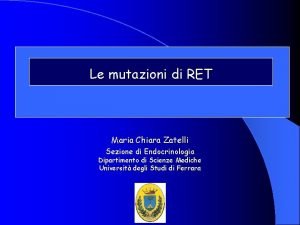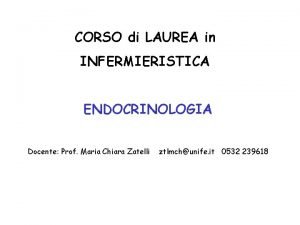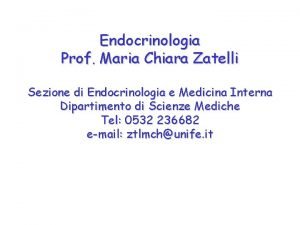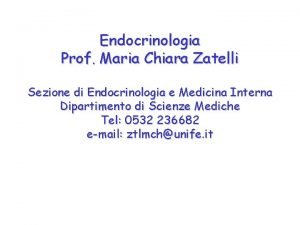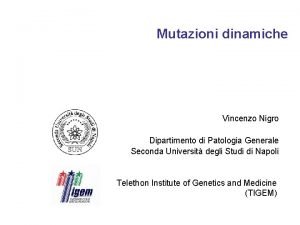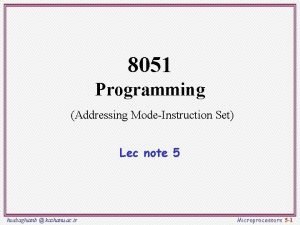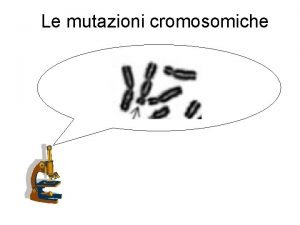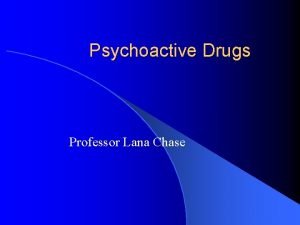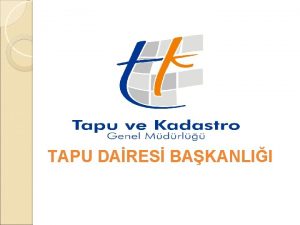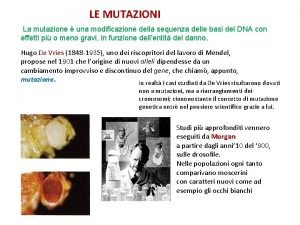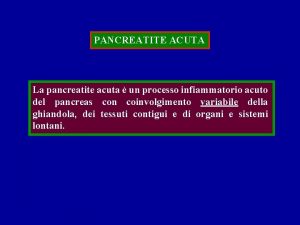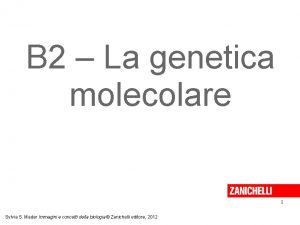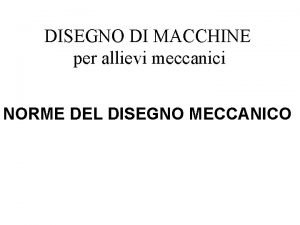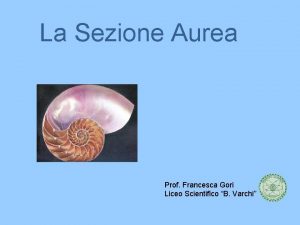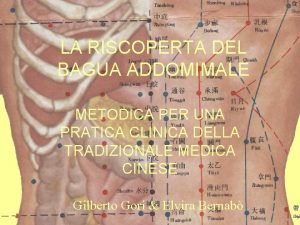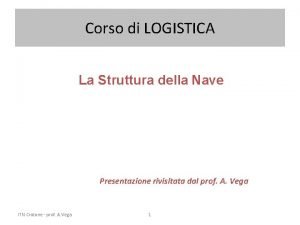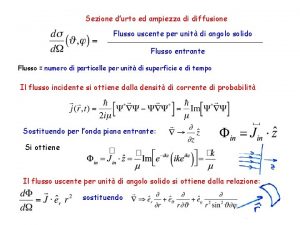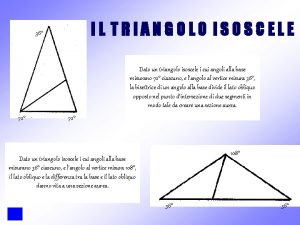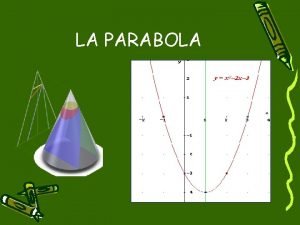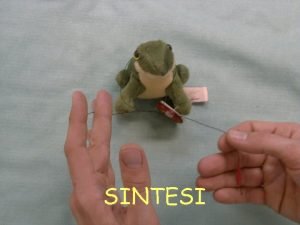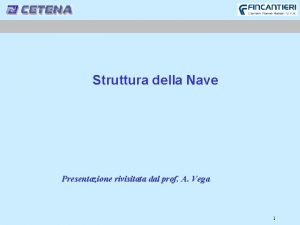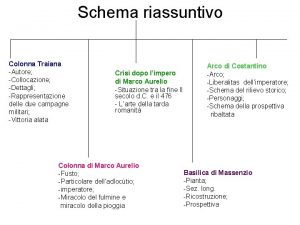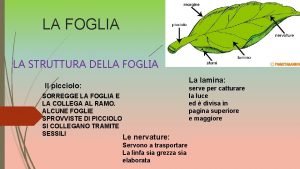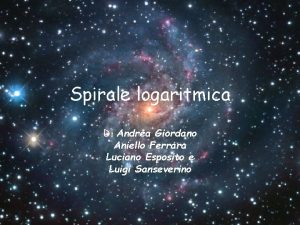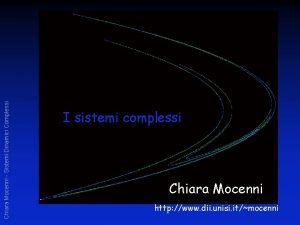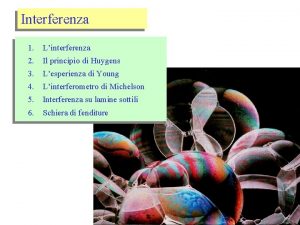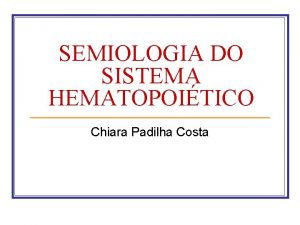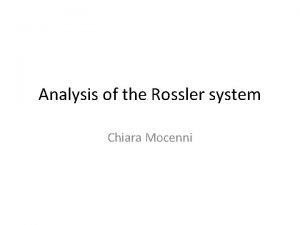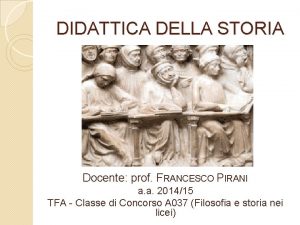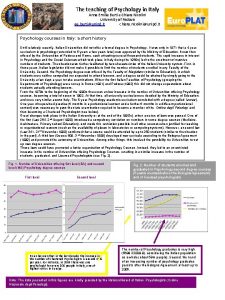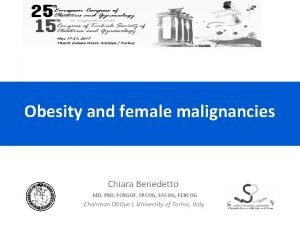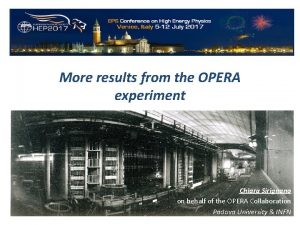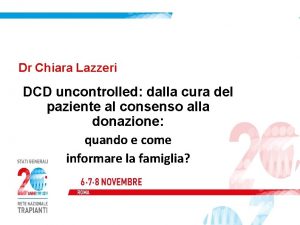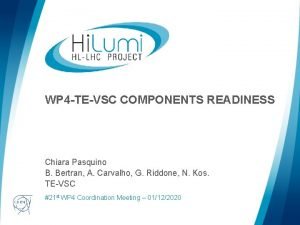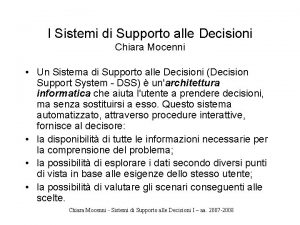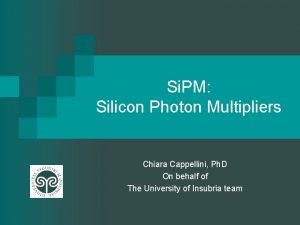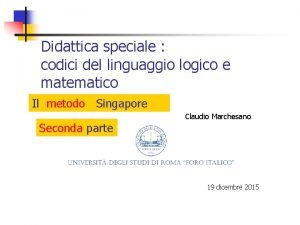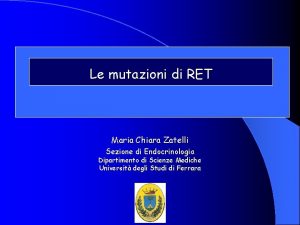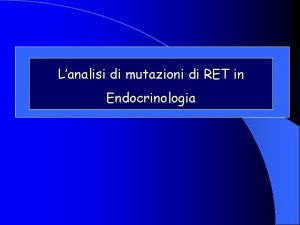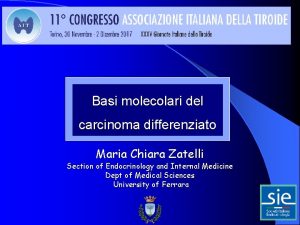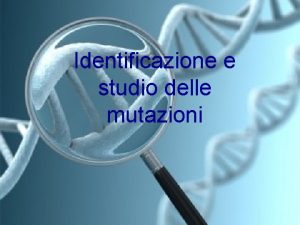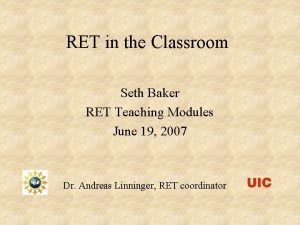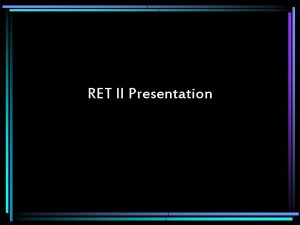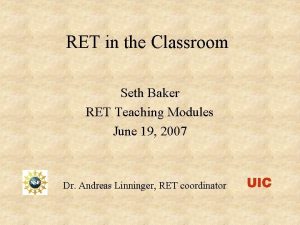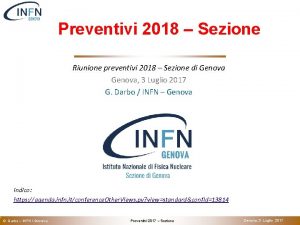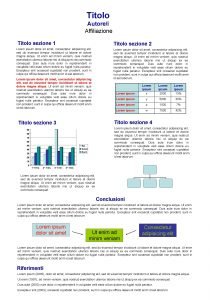Le mutazioni di RET Maria Chiara Zatelli Sezione












































![Drug discovery Durante et al. Endocrine. 2013 Apr 14. [Epub ahead of print] Pub. Drug discovery Durante et al. Endocrine. 2013 Apr 14. [Epub ahead of print] Pub.](https://slidetodoc.com/presentation_image_h/d312abbbd465fa39aa4a446db45dfc3b/image-45.jpg)
















![[3 H]thy incorporation (% vs. control) Drug discovery SSTR 2 SSTR 5 * 200 [3 H]thy incorporation (% vs. control) Drug discovery SSTR 2 SSTR 5 * 200](https://slidetodoc.com/presentation_image_h/d312abbbd465fa39aa4a446db45dfc3b/image-62.jpg)


















- Slides: 80

Le mutazioni di RET Maria Chiara Zatelli Sezione di Endocrinologia Dipartimento di Scienze Mediche Università degli Studi di Ferrara

Biomarkers A biomarker, or biological marker, is an indicator of a biological state, or the past or present existence of a particular type of organism. Biomarkers are objectively measured and evaluated as indicators of normal biological processes, pathogenic processes, or pharmacologic responses to a therapeutic intervention. The presence and concentration of certain molecules, or measured activity such as electrical activity in the brain, provide biomarkers that can be identified and measured. Some of the more colorful and illustrative terms used to describe molecular biomarkers are "signature molecules" and "fingerprint molecules. "

Carcinoma Midollare della Tiroide: MTC Neoplasia maligna derivante dalle cellule C parafollicolari Rappresenta circa il 8% delle neoplasie tiroidee È sporadico nell’ 80% dei casi ed ereditario nel restante 20%. Può presentarsi come lesione nodulare o, più frequentemente, già in fase metastatica (linfonodi locoregionali ed a distanza). Determina una secrezione molto elevata di Calcitonina con comparsa di sintomatologia tipica (diarrea e flushing) possono essere necessari test di stimolo con CALCIO e PENTAGASTRINA Le forme SPORADICHE hanno una maggior incidenza dopo la IV decade Le forme FAMILIARI possono avere esordio molto precoce Le forme FAMILIARI di MTC possono far parte di altre sindromi MEN 2 A: MTC, iperparatiroidismo, feocromocitoma (penetranza 100%) MEN 2 B: MTC, feocromocitoma, neuromi muco-cutanei (penetranza 98%) FMTC: forte predisposizione a sviluppare esclusivamente MTC Sono dovute a mutazioni del PROTO-ONCOGENE RET = tirosino-chinasi di membrana, espressa nel tessuto nervoso ed in molti organi di natura neuroendocrine, nonché a livello renale e nei gangli motori dell’intestino, normalmente attivata dall’interazione con il GDNF

Anomalie molecolari del proto-oncogene RET nella neoplasia multiendocrina di tipo 2 (MEN 2). Mutazioni di RET sono state identificate nella MEN 2 A, nella MEN 2 B, nel Carcinoma Midollare Familiare (FMTC), e negli MTC sporadici Possono colpire: 1= la regione extracellulare ricca in cisteine importante per la dimerizzazione (codoni 609, 611, 618, 620, 634). 2 = la regione tirosino-chinasica intracellulare (codoni 768, 790, 791, 804, 883, 891, 918, 922)

RET mutations in Endocrinology RET (REarranged during Transfection) protooncogene Long arm of chromosome 10 (10 q 11. 2) susceptibility gene for • familial medullary thyroid cancer (FMTC) • pheochromocytoma • parathyroid hyperplasia/adenomas multiple endocrine neoplasia type 2 (MEN 2)

RET mutations in Endocrinology RET transmembrane receptor extracellular domain transmembrane domain tyrosine kinase domain

La tirosin chinasi RET è un recettore di membrana che prende rapporti con un altro recettore di membrana, il glial cell line–derived neurotrophic factor receptor (GFR -1), formando il recettore per il glial cell line–derived neurotrophic factor (GDNF). A: In assenza di GDNF, RET e GFR-1 non formano dimeri, mentre in presenza di GDNF si ha attivazione del complesso recettoriale, autofosforilazione, ed attivazione delle vie di segnale a valle (fosfolipasi C [PLC], p 38 MAPK e JNK). B: Mutazioni del dominio extracellulare ricco in cisteine (codone 634) causano la dimerizzazione e l’autofosforilazione di RET, con attivazione delle vie di segnale a valle C: Mutazioni del dominio chinasico intracellulare (codone 918) causano l’autofosforilazione e l’attivazione del dominio chinasico in assenza di dimerizzazione

RET mutations in Endocrinology RET mutations constitutive supraphysiological activation of the RET receptor tyrosine kinase cell hyperstimulation thyroid C cells adrenal medullary cells parathyroid chief cells

RET mutations in Endocrinology ‘Gain-of-function’ mutations transmembrane domain codon 649 Least high transforming ability RET protein monomers are kept in close proximity to each other through noncovalent receptor–receptor interactions Machens et al. 2009 J Intern Med 266: 114

RET mutations in Endocrinology ‘Gain-of-function’ mutations cysteine-rich extracellular domains codons 515, 609, 611, 618, 620, 634 High transforming ability ligand-independent dimerization and crossphorylation of mutant RET receptor proteins loss of a cysteine residue irrespective of the amino acid substituting for cysteine addition of one more cysteine residue in codons 533, 606 or 631 Machens et al. 2009 J Intern Med 266: 114

RET mutations in Endocrinology Mutations in the Cystein-rich extracellular domain cause RET dimerization and autophosphorylation, independently of the ligand

RET mutations in Endocrinology ‘Gain-of-function’ mutations intracellular tyrosine kinase domain codons 768, 790, 791, 804 and 891 Very high transforming ability facilitate the access of ATP to its binding site preferential binding of intracellular substrate intracellular catalytic core codon 918 Machens et al. 2009 J Intern Med 266: 114

RET mutations in Endocrinology Mutations in the intracellular kinase domain cause RET autophosphorylation, independently of dimerization and of the ligand

RET mutations in Endocrinology GENOTYPE-PHENOTYPE CORRELATION

RET mutations in Endocrinology MEN 2 A: MTC, hyperparathyroidism, pheochromocytoma (100% penetrance) MEN 2 B: MTC, pheochromocytoma, muco-cutaneous neuromas (98% penetrance) FMTC: MTC


RET mutations in Endocrinology Machens et al. 2009 J Intern Med 266: 114

RET mutations in Endocrinology Elisei et al. J Clin Endocrinol Metab 2007, 92(12): 4725– 4729

RET mutations in Endocrinology Machens et al. 2009 J Intern Med 266: 114 Cost-effective identification of affected family members Gilchrist et al. Clin Genet 2004; 66: 349– 53 legal and ethical importance indicating the need for prophylactic thyroidectomy gold standard of care Rosenthal et al Thyroid 2005; 15: 140– 5

RET mutations in Endocrinology Different forms of medullary thyroid cancer 5 th-6 th decade of life within 3 rd decade of life Elisei R 2008 Best Pract Res Clin Endocrinol Metab 22: 941– 953

RET mutations in Endocrinology Hereditary MTC Prospective family screening Germline RET mutations 95% of MEN 2 A kindreds Hirshprung disease Lichen amyloidosis 88% of FMTC kindreds >95% of MEN 2 B kindreds (codon 918) Elisei et al. 2007 J Clin Endocrinol Metab 92: 4725 -9 Castellone et al. 2008 Endocrinol Metab Clin North Am 37: 363 -74, viii

RET mutations in Endocrinology Hereditary MTC 6 -75% of “sporadic” MTC carry a germline RET mutation Elisei et al. 2007 J Clin Endocrinol Metab 92: 4725 -9 Wohllk et al. 1996 J Clin Endocrinol Metab 81: 3740 -3745 RET genetic testing should be encouraged in all newly diagnosed MTC patients The National Comprehensive Cancer Network Clinical Practice Guidelines in Oncology 2009 biochemical screening for MEN 2 hyperparathyroidims pheochromocytoma

RET mutations in Endocrinology Genetic screening in proband in first degree relatives is fundamental High likelihood of developing MTC during lifespan consider prophylactic thyroidectomy follow up

RET mutations in Endocrinology How is genetic analysis perfomed? 1. Patient referral for MTC or family history of MTC 2. History – evaluate family history 3. Clinical examination 4. Informed consent signature 5. Blood withdrawal (no fasting needed) 6. Sample sent to the Lab

RET mutations in Endocrinology amplificazione del DNA GENOMIC DNA DIRECT SEQUENCING denaturation purification DNA isolation purification Sequencing reaction Capillary electrophoresis

RET mutations in Endocrinology Electropherogram analysis by a Technicial by the Physicial in charge Comparison with the normal sequence any SNP? DIAGNOSIS

RET mutations in Endocrinology Risk level Risk RET genotype (mutation in codon) 3 Highest 883, 918, 922 2 High 634, 630, 609, 611, 618, 620 1 Least high 768, 790, 791, 804, 891 Brandi et al. 2001 J Clin Endocrinol Metab 86: 5658– 71 mutation site is one of the most important determining factors of risk and age-related penetrance of a specific RET mutation Moore et al. 2008 Pediatr Surg Int 24: 521– 530

RET mutations in Endocrinology

RET mutations in Endocrinology Sporadic MTC 40 -50% of sporadic MTC display somatic RET mutations Romei et al. 1996 J Clin Endocrinol Metab 81: 1619– 1622 Schilling et al. 2001 Int J Cancer 95: 62– 66 Zedenius et al. 1995 J Clin Endocrinol Metab 80: 3088– 3090 Zedenius et al. 1998 Cancer Detect Prev 22: 544– 548 Somatic RET mutations correlate with • presence of lymph node metastases at diagnosis • worse outcome • disease persistence after surgery • lower survival rate bad prognostic factor Elisei et al. 2008 J Clin Endocrinol Metab 93: 682 -7

RET mutations in Endocrinology

RET mutations in Endocrinology SURGERY total thyroidectomy with dissection of ipsilateral and central neck compartments ? contralateral dissection ? Sporadic MTC Hereditary MTC Asymptomatic RET mutation carriers before MTC occurrence undetectable CT levels in > 95% of cases Kouvaraki et al. Thyroid 2005 15: 531– 544

RET mutations in Endocrinology SURGERY Ideally, prophylactic thyroidectomy should be undertaken before MTC develops in children normal thyroid volume asymptomatic young Miccoli et al. J Endocrinol Invest 2004; 27: 557– 61 Miccoli et al. Surg Endosc 2007; 21: 120– 3

RET mutations in Endocrinology Hereditary MTC SURGERY codon 918 codons 609, 611, 618, 620, 634 codons 768, 790, 791, 804 and 891 Risk level Risk Surgery within 3 Highest within the first 6 months of life 2 High before 5 years of age Least high between 5 and 10 years of age 1 Falchetti et al. 2008 Best Pract Res Clin Rheumatol 22: 149 -63 aggressive neck dissection should be performed with lateral lymph node involvement

RET mutations in Endocrinology SURGERY Very early surgical intervention (<2 yr for exon 9187 mutations or <10 yr) no need for additional lymph node dissection Preserve parathyroid glands ≥ 10 involved lymph nodes autograft no surgical cure Machens et al. Cancer 2000; 88: 1909– 15. Weber et al. . Surgery 2001; 130: 1044– 9. Scollo et al. J Clin Endocrinol Metab 2003; 88: 2070– 5. neck lymph node metastases dissection eliminate the possibility of extranodal growth Machens et al. Surgery 2001; 129: 23– 8 avoid reoperations Thomusch et al. Surgery 2003; 133: 180– 5. Dralle et al. Surgery 2004; 136: 1310– 22.

RET mutations in Endocrinology

RET mutations in Endocrinology

Drug discovery TYROSINE KINASE INHIBITORS Fagin 2004 J Endocrinol 183, 249

Drug discovery TYROSINE KINASE INHIBITORS Imatinib - (STI 571; Gleevec) Abl CML Kit gastrointestinal stromal tumors (GIST) PDGF receptor Deininger MW. J Cancer Res Clin Oncol 2004; 130: 59 RET (? ) Cohen et al. 2002 Surgery 132, 960– 967 Skinner et al. 2003 Anticancer Res 23, 3601 Ezzat et al. 2005 Clin Can Res 11: 1336 ZD 6474 - anilinoquinazoline VEGF receptor 2 RET/PTC RET (MEN 2 B) Carlomagno et al. . Cancer Res 2002; 62: 7284 Kodama et al. Cancer Sci 2005; 96: 147 non-small cell lung cancer breast cancer Putzer et al. Trends Mol Med 2004; 10: 351

Drug discovery TYROSINE KINASE INHIBITORS pyrazolo-pyrimidine PP 1 - PP 2 RET tyrosine kinase mutation of valine 804 of RET causes resistance to PP 1, PP 2 and ZD 6474 Carlomagno et al. Cancer Res 2002; 62: 1077 Liu et al. J Clin Endocrinol Metab 2004; 89: 3503 proteosomal targeting Carlomagno et al Oncogene 2004; 23: 6056 RET-MEN 2 A and RET-MEN 2 B oncoprotein degradation Carniti et al. Cancer Res 2003; 63: 2234 Kodama et al. Cancer Sci 2005; 96: 147

Drug discovery TYROSINE KINASE INHIBITORS indolocarbazole derivatives CEP-701 CEP-751 RET autophosphorylation TT cell proliferation - Strock et al. Cancer Res 2003; 63: 5559 2 -indolinone derivative RP 1 - RET tyrosine kinase and down-stream signalling Cuccuru et al. J Natl Cancer Inst 2004; 96: 1006 Kodama et al. Cancer Sci 2005; 96: 147 lack of critical selectivity

Drug discovery TYROSINE KINASE INHIBITORS

Drug discovery

Drug discovery TYROSINE KINASE INHIBITORS phase II trials • prolonged disease stabilization • clinical benefits in 50% of the patients • partial tumor responses in only few patients • no improvement in survival so far Sherman J Clin Endocrin Metab published online March 3, 2009 targeting RET is not sufficient to treat all MTC tumors Schlumberger et al. Nat Clin Pract Endocrinol Metab. 2008; 4: 22 -32

Drug discovery
![Drug discovery Durante et al Endocrine 2013 Apr 14 Epub ahead of print Pub Drug discovery Durante et al. Endocrine. 2013 Apr 14. [Epub ahead of print] Pub.](https://slidetodoc.com/presentation_image_h/d312abbbd465fa39aa4a446db45dfc3b/image-45.jpg)
Drug discovery Durante et al. Endocrine. 2013 Apr 14. [Epub ahead of print] Pub. Med PMID: 23584948.

Drug discovery ANTIBODIES humanized monoclonal antibodies against oncogene products Trastuzumab Erb. B 2 breast cancer Herceptin IMC-C 225 cetuximab Erb. B 1 colorectal cancer Roskoski R Jr. Biochem Biophys Res Commun 2004; 319: 1 Ab anti-Tyr 1062 RET-Tyr 1062 Yano et al. 2000 Hum. Gene Ther, 11: 995 MTC

Drug discovery RIBOZYMES = RNA enzymes RNA molecules that can catalyze a chemical reaction, such as their own cleavage or the cleavage of other RNAs MEN 2 A-derived RET-selective ribozyme MEN 2 A-derived RET RNA specific cleavage RET-mediated transformation Parthasarathy R et al. 1999 Cancer Res. 59, 3911 highly selective

Drug discovery GENE THERAPY RECOMBINANT ADENOVIRUS VECTORS infection of both proliferating and quiescent cells produced in very large quantities and high titers high-efficiency gene transfer and expression no significant potential for integrating into genomic DNA selection of the promoter specifically and selectively driving the expression of the transduced gene incorporation of large fragments of foreign DNA serving as a transgene Bockmann et al. J Gene Med 2005, 7: 179

Drug discovery GENE THERAPY HSVtk/GCV system (Moolten 1986) HSVtk gene GCV P GCV HSVtk suicide gene cell kinases P cell death DNA chain termination GCV P P

Drug discovery GENE THERAPY Ad. DCTtk Minemura 2000 CT promoter Ex 1 Ex 3 Ex 4 C cell HSVtk Ex 4 Ex 5 GCV suicide gene other cells splenocyte hepatocyte specific cell killing macrophages

Drug discovery GENE THERAPY Ad. CMVTKh. IL 2 Zhang et al. Endoc Rel Can 2001, 8: 315 CMV TK PA CMV TK h. IL 2 PA GCV suicide gene IL 2 antitumoral effect cell killing

Drug discovery GENE THERAPY vaccine DNA vaccines Haupt 2001 CMV promoter Pre-pro-calcitonin c. DNA CT antigen-specific cellular and humoral immune response against h. PPCT APC differentiation of dendritic cells GM-CSF + Caux 1992 antigen-presenting cells Tazi 1993 CMV promoter GM-CSF c. DNA antigen-presenting ability Fischer 1988

Drug discovery IMMUNOTHERAPY CD 40 -ligation DC vaccination Schott et al. J Clin Endocrinol Metab 2001; 86: 4965 inflammatory cytokines DC bacterial products maturation antigen-presenting capacity MHC expression migration into secondary lymphoid organs priming naïve T cells Cella 1997 the most potent antigen-presenting cells for naïve T-cell activation Banchereau 1998

Drug discovery IMMUNOTHERAPY CEA and CT DC vaccination Schott et al. J Clin Endocrinol Metab 2001; 86: 4965 DC maturation induction of a T cell-dependent immunity clinical response: 3/7 with significant regression of liver and pulmonary lesions in 1 case

Drug discovery IMMUNOTHERAPY human MTC cell lysate DC vaccination Bachleitner-Hofmann et al. J Clin Endocrinol Metab 2002; 87: 1098 DC TNF, GM-CSF, IL-4 maturation cytotoxic T-cell MTC

Drug discovery IMMUNOTHERAPY human autologous MTC cell lysate DC vaccination Stift et al. Clin Can Res 2004; 10: 2944 DC maturation TNF, GM-CSF, IL-4 ± IFNg MTC tissue preparation

Drug discovery IMMUNOTHERAPY DC vaccination Stift et al. Clin Can Res 2004; 10: 2944 10 patients with advanced metastatic disease ü no major toxicity 3 objective partial response ü no development of autoimmune 1 minor response disease ü transient rise in auto-antibodies 2 stable disease ü well tolerated 4 progressive disease ü performed on an outpatient basis 7 transient or prolonged decline of at least one tumor marker

SS Forsk TR 1 Drug discovery + AC CT c. AMP P P CREB CRE CT PKA P P CREB CT CT CT gene transcription SR SS B IF TR Forsk - + A AC - CRE - P P CREB CT CT PKA c. AMP P P CREB 1 CT CT CT gene transcription CT

T SS RE TK P P + Drug discovery TR SHP-1 RAS RAF ERK PP ERK SR T RE cell proliferation IF TR TK P P - SHP-1 RAS RAF ERK + B SS + A PP ERK cell proliferation

Drug discovery A p. MAPK tot MAPK SRIF - + V - - + + B ERK 1/p 44 ERK 2/p 42 sta rv ed p. MAPK ERK 1/p 44 ERK 2/p 42 tot MAPK ERK 1/p 44 ERK 2/p 42 1 P-1 HP- NA 3 H S S c. D wt DN p Ip SHP-1 SSTR 2 SHP-1 SRIF - - + V - - - + +

Drug discovery ANALOGS WITH ENHANCED SSTR 2 AFFINITY and SELECTIVITY REPRESENT POTENTIAL ANTIPROLIFERATIVE AGENTS for MTC IMPORTANCE of SSTR 2
![3 Hthy incorporation vs control Drug discovery SSTR 2 SSTR 5 200 [3 H]thy incorporation (% vs. control) Drug discovery SSTR 2 SSTR 5 * 200](https://slidetodoc.com/presentation_image_h/d312abbbd465fa39aa4a446db45dfc3b/image-62.jpg)
[3 H]thy incorporation (% vs. control) Drug discovery SSTR 2 SSTR 5 * 200 * 150 50 no influence on CT secretion and m. RNA expression 0 Zatelli MC et al Horm Metab Res 2002 -50 SSTR 2 agonist SSTR 5 agonist * * 10 -7 0 10 -7 10 -9 10 -7 0 10 -7 M M *p<0, 05 vs control SSTR 2 and 5 antagonism in suppressing cell proliferation in human medullary thyroid cells Zatelli MC et al J Clin Endocrinol Metab 2001

Drug discovery ANALOGS with HIGH AFFINITY for SSTR 1 9 8 7 6 5 4 3 2 1 0 ** fold-induction cell proliferation TT CT secretion + * + 70 60 30 20 10 CT CREB GAPDH + - + + Forsk BIM-23926 BIM-23745 c. AMP pathway 40 p. CREB + - ** 50 0 - CT m. RNA expression Forsk - BIM-23926 BIM-23745 - * + - + Zatelli MC et al Biochem Biophys Res Commun 2002 * + + * - + + - - +

Drug discovery SS SR IF TR Forsk 1 - + AC - CT CT CT c. AMP PKA P P P CREB gene transcription CRE CT CT CT

Drug discovery ANALOGS with HIGH AFFINITY for SSTR 1 CELL PROLIFERATION CT GENE EXPRESSION CT PROTEIN SECRETION MIGHT BE USEFUL to CONTROL MTC GROWTH and SECRETORY ACTIVITY Zatelli MC et al Biochem Biophys Res Commun 2002

Drug discovery CHEMOTHERAPY overexpression by MTC of the mdr-1 gene gp-170 chemoresistance antagonizes intracellular accumulation of cytotoxic agents confers the multidrug resistance Yang et al. 1991 Anticancer Research 11: 1065 CHEMOTHERAPY SHOULD BE USED ONLY IN PATIENTS WITH RAPID PROGRESSION OF METASTATIC DISEASE Leboulleux et al. Clin Endocrinol 2004: 61, 299

Drug discovery To evaluate the MDR-1 expression and function in MTC primary cultures and in a human MTC cell line, TT, testing a possible modulation of MDR-1 by COX-2 inhibitors in order to define the role of COX-2 pathway in MTC chemoresistance

Drug discovery • Primary cell culture • TT cell line • Viable cell number assays • RT-PCR analysis • Protein expression analysis • Rhodamine assay

Drug discovery MDR-1 and COX-2 expression in MTC MDR-1 and COX-2 are expressed in 12 human MTC and in TT cells

Drug discovery EFFECTS of DOXORUBICINE on TT cell viability Doxorubicine (n. M) TT cells are highly chemoresistant

Drug discovery EFFECTS of VERAPAMILE, ROFECOXIB, NS-398 and PGE 2 on TT CELL VIABILITY Verapamile, Rofecoxib, NS-398 and PGE 2 do not affect TT cell viability

Drug discovery EFFECTS of COMBINED TREATMENT with DOXORUBICIN and VERAPAMILE or NS-398 on TT CELL PROLIFERATION Verapamile, Rofecoxib, and NS-398 sensitize TT cell to the cytotoxic effects of doxorubicin

Drug discovery EFFECTS of DOXORUBICIN and ROFECOXIB on MTC PRIMARY CULTURE CELL VIABILITY Verapamile, and Rofecoxib sensitize MTC primary cultures to the cytotoxic effects of doxorubicin

Drug discovery EFFLUX EVALUATION by R 123 assay Verapamile and Rofecoxib inhibit P-gp function

Drug discovery Effects of rofecoxib and PGE 2 on MDR 1 expression Rofecoxib inhibits MDR 1 expression independently on PGE 2 generation

Drug discovery EFFECTS of PGE 2 on TT CELL PROLIFERATION PGE 2 does not revert the sensitizing effect of COX-2 inhibitors PGE 2 in combination with COX-2 inhibitors has an even greater sensitizing effect

Drug discovery Effects of NS-398, PGE 2 and PGH 2 on P-gp expression P-gp actin NS-398 - + - + PGE 2 - - + + PGH 2 - - + + NS-398 inhibits P-gp expression independently on PGE 2 generation …but PGH 2 reduces these inhibitory effects! PGH 2 mediates the inhibitory effects of COX-2 inhibitors on P-gp

Drug discovery v Our results provide further support to the hypothesis that MTC chemioresistance might be due to MDR 1 overexpression v Selective COX-2 inhibitors reduce P-gp expression and function through a mechanism independent of PGE 2, but involving PGH 2 Significant reversal of the drug resistance phenotype

RET mutations in Endocrinology • Most MTC cases are cured by initial surgery when performed at an early stage • Disease can persist or recur and metastasis can occur, with potentially serious effects on quality of life and mortality

RET mutations in Endocrinology • New drugs that rely on knowledge of molecular oncology in MTC are available and are needed for patients with metastatic MTC • Well-designed clinical trials should help in selecting the most active compounds
 Maria chiara zatelli
Maria chiara zatelli Iperosmolarita
Iperosmolarita Maria chiara zatelli endocrinologia
Maria chiara zatelli endocrinologia Maria chiara zatelli
Maria chiara zatelli God ret
God ret Fenomeno miotonico
Fenomeno miotonico Mutazioni genetiche
Mutazioni genetiche Mutazioni puntiformi
Mutazioni puntiformi Mutazioni
Mutazioni Xrl in 8051
Xrl in 8051 Poliploidia
Poliploidia Mutazione missenso
Mutazione missenso Praiprism
Praiprism So sánh trùng kiết lị và trùng sốt rét
So sánh trùng kiết lị và trùng sốt rét Ret tapu
Ret tapu Mutazioni
Mutazioni Poliploidia
Poliploidia Keratocysta
Keratocysta Dalr ret
Dalr ret Ansa sentinella pancreatite
Ansa sentinella pancreatite Mutazioni puntiformi
Mutazioni puntiformi Ret 9
Ret 9 Annunciazione leonardo sezione aurea
Annunciazione leonardo sezione aurea Disegno pezzi meccanici
Disegno pezzi meccanici Cai sezione di castelli te
Cai sezione di castelli te Sezione aurea ppt
Sezione aurea ppt Sezione polizia stradale ancona
Sezione polizia stradale ancona Partenone sezione aurea
Partenone sezione aurea Sezione aurea terapeutica
Sezione aurea terapeutica Diffusione thomson
Diffusione thomson Paratia corrugata
Paratia corrugata Sezione di gola
Sezione di gola Fibre muscolari
Fibre muscolari Flusso uscente
Flusso uscente Immagini di un triangolo isoscele
Immagini di un triangolo isoscele Parabola come conica
Parabola come conica Supramid suture
Supramid suture Nave a struttura trasversale
Nave a struttura trasversale Colonna traiana vittoria
Colonna traiana vittoria Archi faringei
Archi faringei Sezione maestra barca
Sezione maestra barca Lamina della foglia
Lamina della foglia Spirale aurea costruzione
Spirale aurea costruzione Spirale logaritmica costruzione
Spirale logaritmica costruzione Maria felicia de jesús sacramentado maría teresa arminda
Maria felicia de jesús sacramentado maría teresa arminda Chiara moscardini
Chiara moscardini Chiara goretti
Chiara goretti Chiara zanichelli
Chiara zanichelli Relazioni significative
Relazioni significative Chiara mocenni
Chiara mocenni Interferometro di young
Interferometro di young Chiara hematologista pelotas
Chiara hematologista pelotas Chiara lubich
Chiara lubich Chiara capretti
Chiara capretti Chiara mocenni
Chiara mocenni Chiara zampolli
Chiara zampolli Chiara salvelli
Chiara salvelli La locandiera importanza oggetti
La locandiera importanza oggetti Chiara berti clark
Chiara berti clark In un certo mese dell'anno per 3 volte il martedi
In un certo mese dell'anno per 3 volte il martedi Chiara speranza
Chiara speranza Chiara petrillo
Chiara petrillo Frases de chiara lubich
Frases de chiara lubich Rimandatemi il cor empio tiranno
Rimandatemi il cor empio tiranno Chiara benedetto
Chiara benedetto Chiara sirignano
Chiara sirignano Dcd maastricht classification
Dcd maastricht classification Chiara pasquino
Chiara pasquino Chiara francalanci
Chiara francalanci Chiara mocenni
Chiara mocenni Chiara ratzenberger
Chiara ratzenberger Chiara cappellini
Chiara cappellini Chiara benedetti psicologa
Chiara benedetti psicologa Chiara paderni
Chiara paderni Chiara ballarini
Chiara ballarini Chiara agnelli
Chiara agnelli Sistemi dinamici unisi
Sistemi dinamici unisi Andrea beatrice chiara davide enea e federico
Andrea beatrice chiara davide enea e federico Traduttore inglese italiano
Traduttore inglese italiano Chiara elisabetta
Chiara elisabetta Lambda lunghezza d'onda
Lambda lunghezza d'onda
